elemental … d'eau
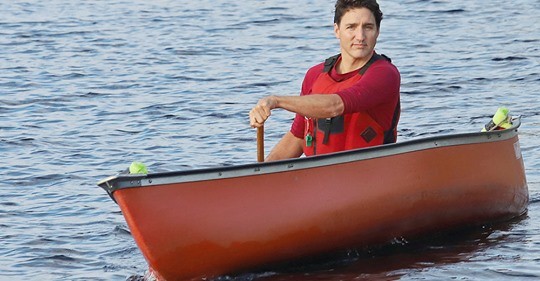
What I instantly discerned from Trudeau’s canoe image was a kinship. Justin is sitting in the tumblehome of the canoe, paddling and manoeuvering it with a J-stroke, steering technique. Both his seated position in the canoe – at the center or balance and pivot point of the canoe – and his turned over wrist near the end of his stroke, tell me he was taught how to canoe and that he is an accomplished canoeist. And I am not being politically naieve here; I am fully aware of how politicians pose and do photo-ops and seize all manner of opportunities for political leverage. This photo may have been connected with Justin’s promise to support programs to teach all Canadian children camping skills by grade 8 – admirable, in my opinion, and very difficult to implement logistically. Interestingly, when the National Physical Fitness Act was passed in 1943, one of its objectives – never realized – was to have every child get 1 month canoeing annually. And there is that wonderful, patriotic aphorism attributed to the Canadian writer, Pierre Berton: “a Canadian is someone who knows how to make love in a canoe” – an observation that conjures one’s imagination indeed. Regardless, I am looking at this image just as a canoeing picture. In all likelihood, Justin learned his canoe prowess from his father, Pierre Trudeau, himself an avid and accomplished canoeist…
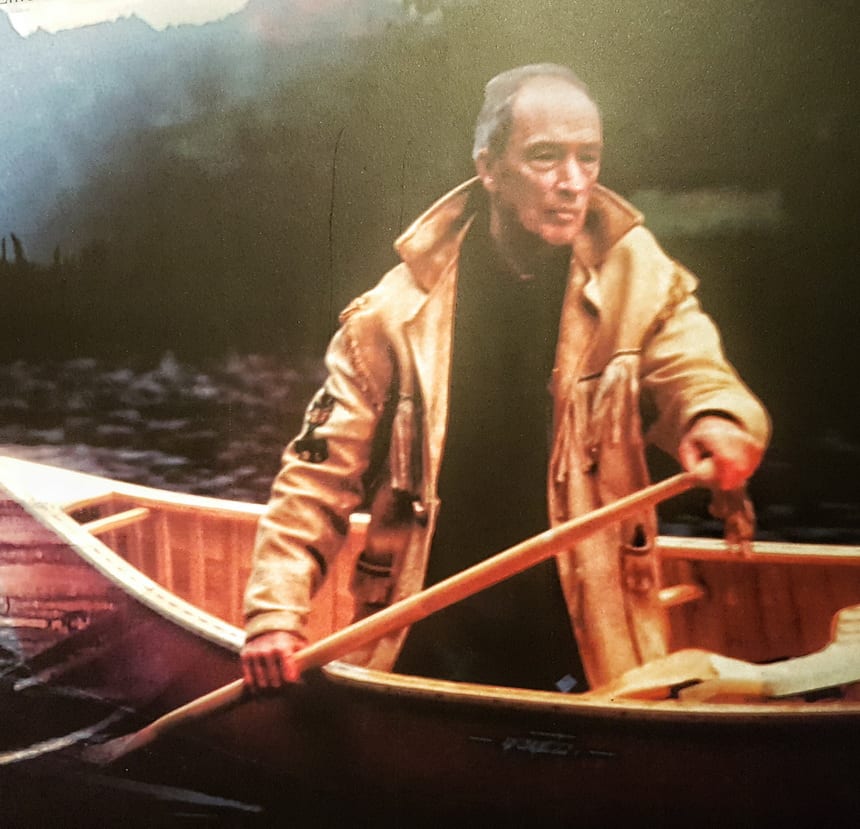
In Pierre Trudeau’s essay, Exhaustion and Fulfillment: The Ascetic in a Canoe (first published in French in 1944, then in English in 1970), he opined, “Travel a thousand miles by train and you are a brute; pedal five hundred on a bicycle and you remain basically a bourgeois; paddle a hundred in a canoe and you are already a child of nature.” It is not my purpose here to examine the political ramifications of either of these two famed Canadians. Rather, I seek to hold a mirror up to how much being in a canoe meant to them, albeit prefatory to my comments in this blog. Herein, I want to ruminate about water as one of the 5 elements ~ Space, Earth, Air, Fire, and Water, the building blocks of all material existence ~ and the one with which I have identified the most – at least alongside Earth whereon I run. It is from Water wherein during my youth I gained such formative and rich experiences and life-lessons.
When did water become of intrigue to me? My earliest memory is of my fascination with our family’s very unique, I thought, red, water sprinkler, something like the one in the image below. I can remember running through its water-jets for hours, seemingly. Part of the thrill was arming myself with my black, plastic squirt gun, and contriving some good-guys vs bad-guys game to play with my friends, all the while running through the sprinkler.
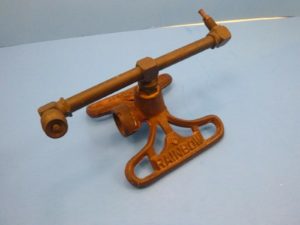
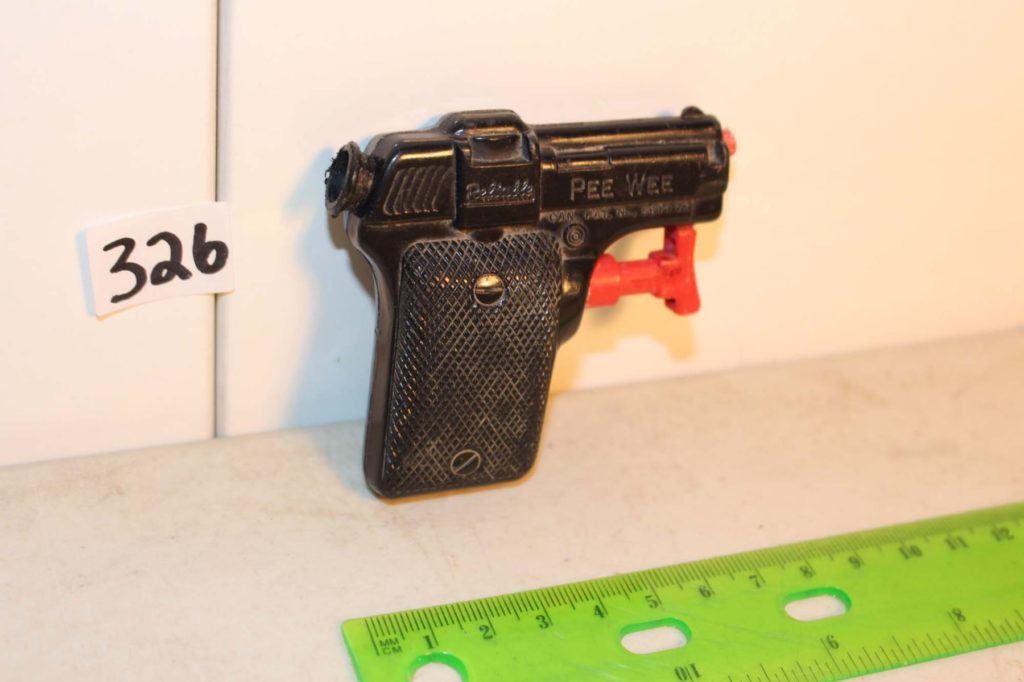
My water pistol was exactly like the one pictured above. It could be filled & re-filled easily through the plug on the back and it seemed to have a remarkable range with a powerful, narrow jet of water. And I know myself well enough to speculate I used it whenever I could get away with it in ‘shooting’ my sisters. How robust seem those days, those sprinkler and water-pistol times at this point in my life
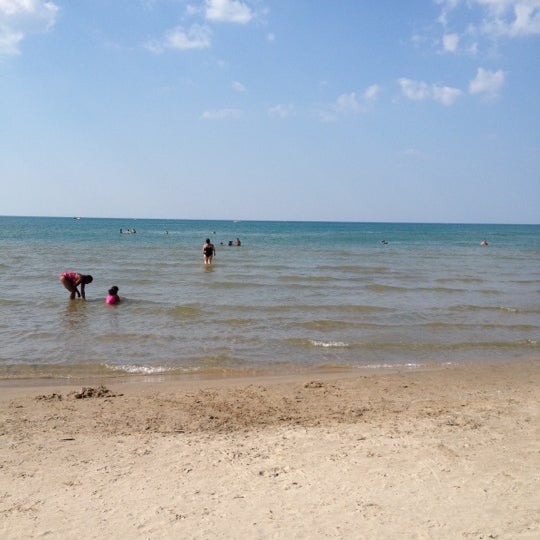
Beaches, cottages on water, rivers, and swimming pools loomed large in my life, from childhood through adulthood. The warm, fresh waters of Port Franks on Lake Huron seemed like my domain as a child. Port Franks was, still is renowned for its sand dunes as you enter the port and for the number of sand-bars that existed within easy reach of walking and swimming to them from the shoreline. Families could drive onto the broad sand-beach and I could and did spend hours building sand castles, making moats, diving down and swimming through my father’s legs as he stood astride in waist-high water for us. Occasionally, we would go to the Pinery Provincial Park, mostly for picnics in the park areas; the beaches there seemed less inviting to me. I can still taste the fizzies we drank; they were large tablets that created a carbonated (bubbly) simulated soft drink when added to water. Fizzies came in flavors like grape, orange, cherry, lemon-lime, strawberry, root beer, and maybe even cola – fruit-flavoured bromo seltzer tablets, I learned later in life. How simply water could be made to taste flavourful.
Swimming was an activity to which I was introduced curiously, at least, as that initiation is indelibly imprinted in my memory. Somehow, I was entered in a backstroke race either when our family was stationed at Centralia Air Force base, or, after we moved to Exeter. And just maybe I asked to be entered. Nevertheless, I did not know how to do the backstroke, had never been in a swimming race. I remember the terror of gulping mouthfulls of water, trying, in vain mostly, to get my body to stay on top of the water and yet, refusing to quit, and likely finishing last. For many years, I couldn’t recall where the pool was located and could not find mention of a pool at the Centralia base until I found the diagram below showing the ‘swim pool’ next to the Rec Centre, lower left:
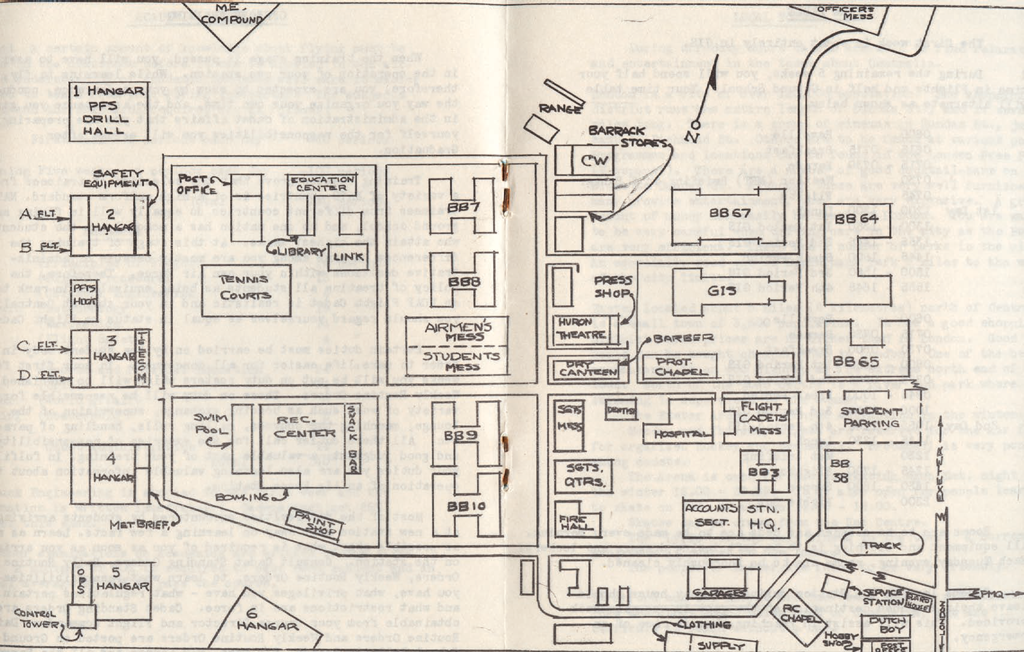
Much more pleasant are my fond reminiscences of swimming and the lure of the water in Exeter’s Ausable River. In the early 1960s, there was no pool in the town. A park that I remember as Riverview Park in the north end, had a sand-embanked swimming area on the River. An L-shaped, yellow painted raft, perhaps 6 feet wide and 30-40 feet along each length, was anchored offshore with affixed buoy lines demarking the shallow area. The ‘pool’ was lifeguarded in the summer; in fact, one of my best friend’s brothers was often in the lifeguard chair. Tanned and sporting a bright blue, Speedo-like bathing suit, I coveted both his job and the Royal Life Saving Society badge emblazoned on his suit. I took swimming and life-saving lessons there achieving Senior Red Cross or some such distinction. Vividly, I recall coming home one day to tell my family I had learned a new swimming style, the ‘yellow belly sapsucker’ stroke. It was, of course, the elementary back stroke but I was convinced I had heard it as yellow belly. Perhaps it harkened back to the terror of my Centralia backstroke experience and I made up the name to colour it.
I suspect achieving the RLSS badges was my main motivation for learning to swim. And yet, even in Exeter, swimming was not the attraction to the River. On the far side of the yellow raft was the deep-water area and we, my friends and I relished diving from that side of the raft. Cows grazed in the field on the other side of the river and we enjoyed swimming toward that shore. Even more alluring was the long swim adjacent to the shoreline toward the Waterworks dam:
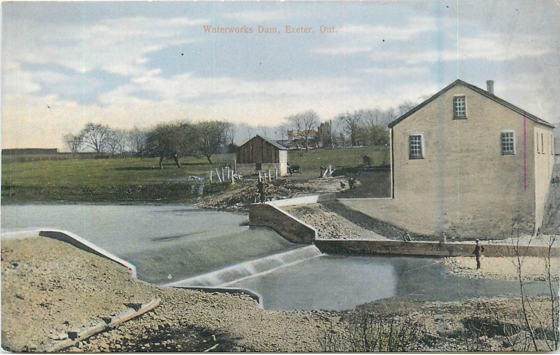
Completing the quarter mile swim was regarded as its own badge of honour among us and I endeavored to do the crawl stroke all the way their as though some private endurance test. However, it was the dam that drew us for two reasons. One, we spent hours sliding down the moss-covered, pebbled-cement dam itself; the water was shallow and slow flowing and yet just steep enough to provide a fairly fast ride to the river-pool at the bottom. Much to my father’s consternation, I wore out many a bathing suit bottom sliding down the dam. The other feature was the cement parapet we could reach by crossing the dam. Just beyond the left edge of the dam image framed above were two, parallel cement walls about 6 feet apart that jutted out into the river. I have no idea now what practical purpose the walls served; for us, they were diving walls. The challenge was that the walls were about 6 or 7 feet above the water and the water was not all that deep, perhaps 5 or 6 feet. Thus, each dive had to be executed such that we had to start to arch upwards just as we entered the water to avoid hitting the bottom and some steel beam that had been left or positioned at the bottom. Very likely, the diving was prohibited, certainly not safe, and yet we did it…because we could. In that same spirit, love of water, doing something just so neat, my cousin, Rick, and I built rafts like the one below and poled them at Port Ryerse on Lake Erie:
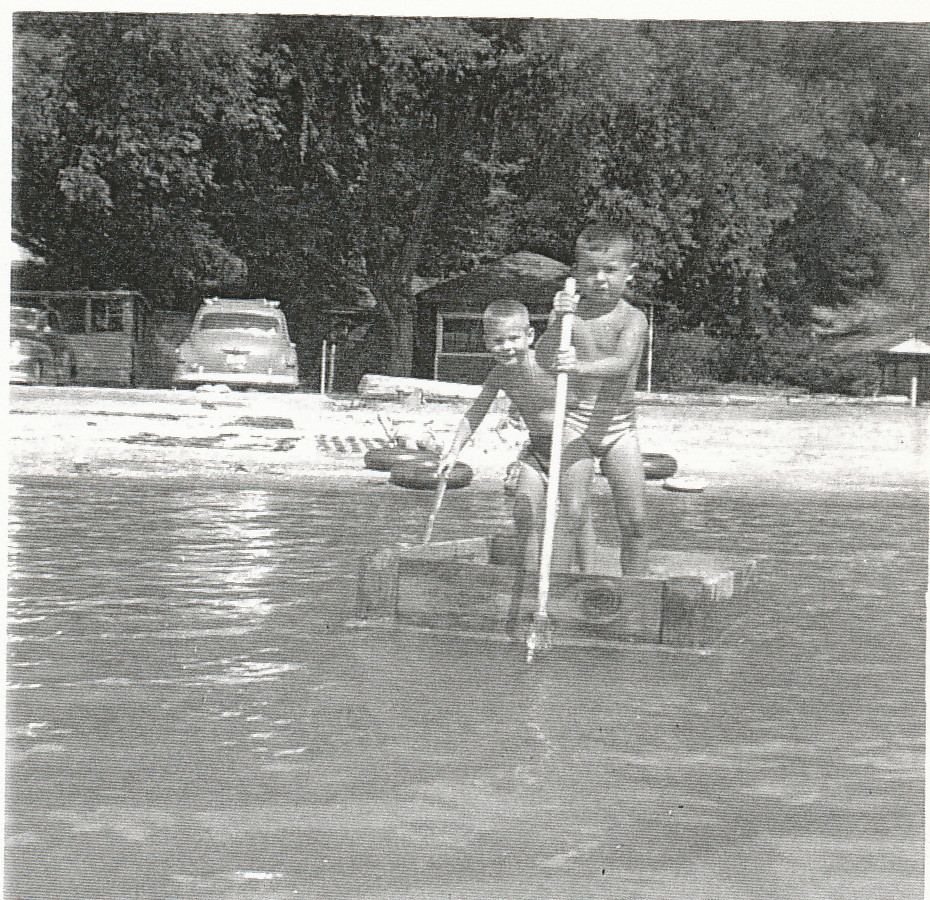
My final memory about water, swimming and their malleable impact on me comes from my early teen, high school years living in London, Ontario. At the downtown YMCA – where my parents were married, as I now know – I spent many Saturdays playing basketball, doing stunts on the trampoline, and swimming. For reasons I never questioned, all swimming at that ‘Y’ was done nude, among boys and men. I don’t remember thinking anything of it – it was just the way swmming happened. The best current explanation of the male, nude-swimming tradition comes from a Lutheran pastor, Frank Senn who rationalized its practice as develolping from broad-based physical culture and muscular Christianity movements that extolled physical health at least for men – see Frank Answers about Swimming Naked in the YMCA. For me, it was normal, part of the Y, going to the gym, and being a young man among other young men, boys, and men – just natural, a figurative and literal fluidity about being male.
So many, many memories are connected to and with water from my boyhood and youth days. Of course, when frozen, water offered me hibernal wonders and opportunities, such as building igloos or snow-forts like the one in Trenton with my sisters below:
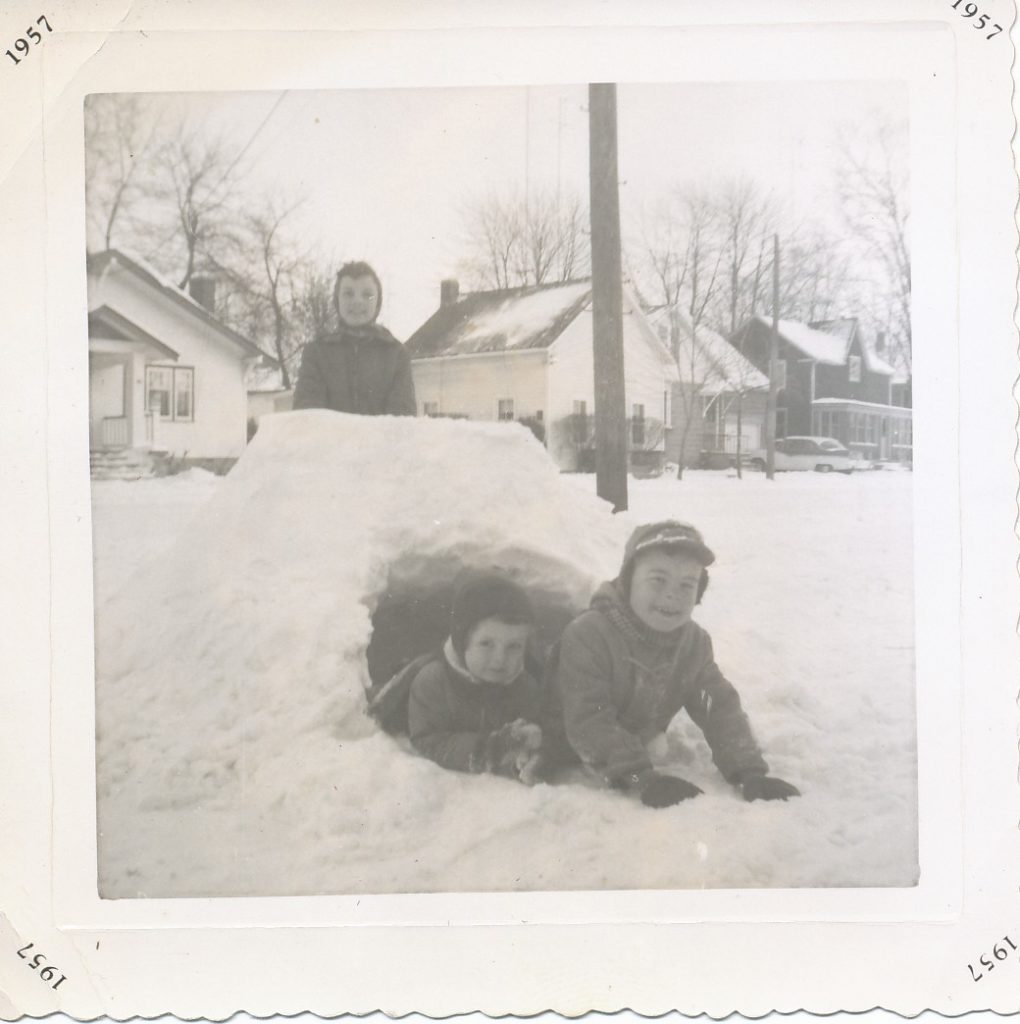
Even earlier, when still living in Centralia, I longed to play hockey. My mother, wisely as I see it now, mandated that I learn to skate before playing the game. And so I was enrolled in figure skating classes, long before the notion of “power skating” – equals figure skating in macho disguise – captured the same market for instilling skating skills. I don’t know how long I took lessons but I distinctly recall the end result one year when I played a toy soldier in the skating carnival dressed as such in the picture below (I am holding figure- not hockey-skates):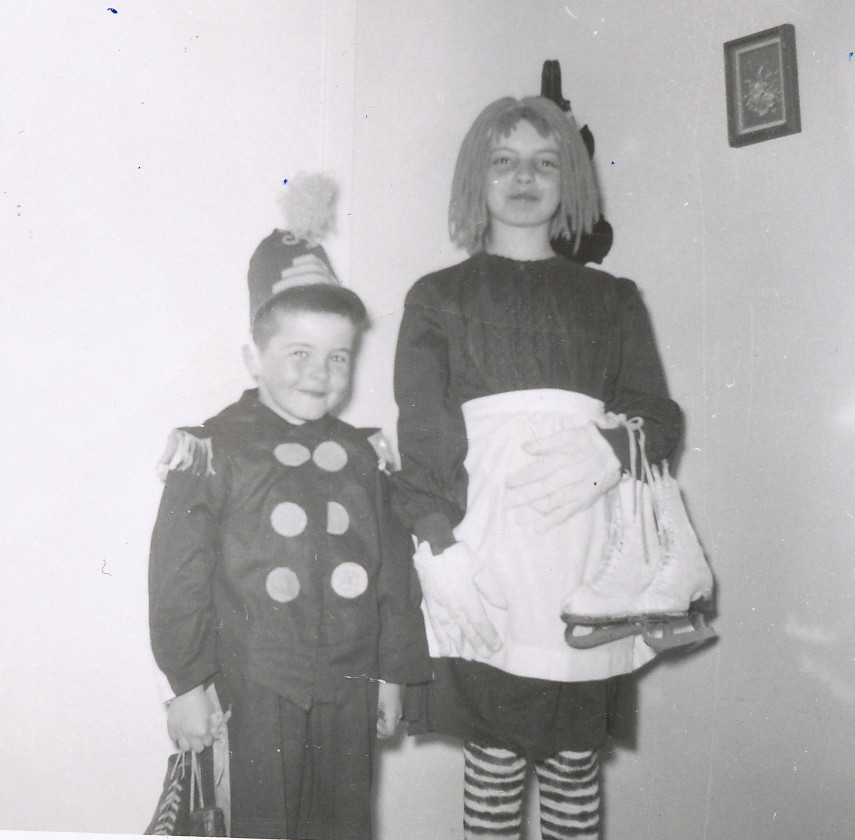
I assume Sandi was Raggedy Ann. Regardless, we had to go to the Exeter arena for the lessons, a 10-15 minute drive from the PMQs, our home in Centralia. Too young to tie my own skates, at the end of dress rehearsal – or maybe the actual performance – someone, perhaps my sister, told me to go wait outside the arena door for one of our neighbours to drive us back to Centralia. Uncharacteristically obedient, I did so and stood, in my soldier’s attire, on the hinge side of the big, green arena door. It was snowing quite heavily and visibility was not good. I just stood and waited. Perhaps they just didn’t see me behind the door when it opened. Turns out, my ride left without me, got all the way back to my house where my mother, I assume, asked where I was. Apparently, when they returned to get me, there I stood, looking very soldier-ly, at attention next to the arena door.
Lastly, more than any other of my winter, frozen-water interests was ice hockey. I just could not get enough of playing the game in my youth. My father spent countless frigid hours making back yard rinks like this one behind our home at 90 Byron Street in Trenton:
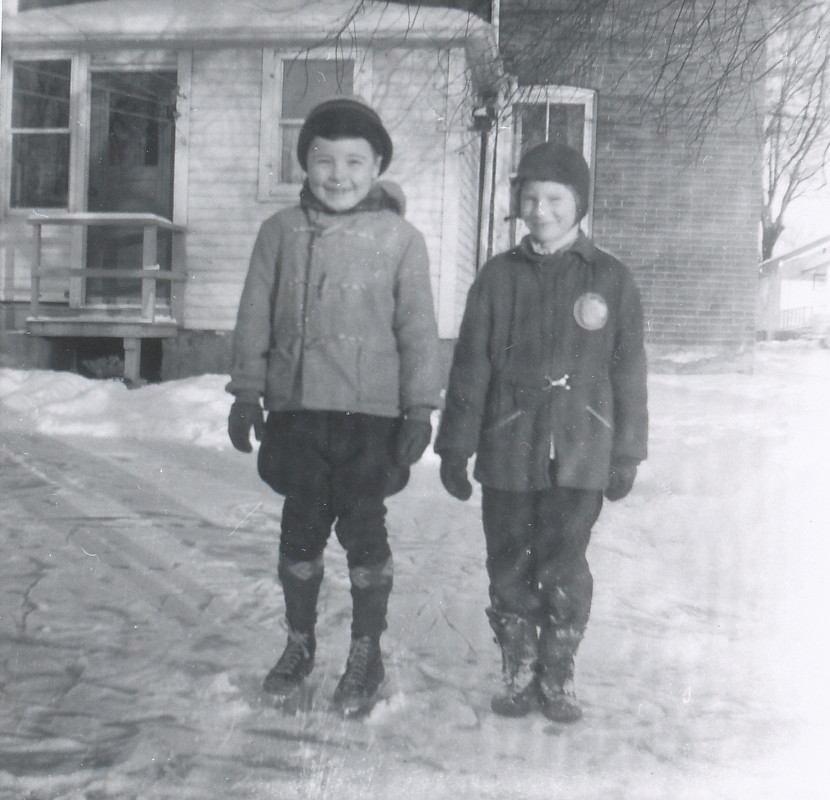
Beside me is my then best friend, Don Smith. And I notice too the breeches or breeks I loathed but my parents thought were the best pants for me; with knee-high socks and worn by so few (any?) of my friends, I found them ridiculous and longed to grow out of them and/or into being allowed to wear pants in the winter. My father either could not or did not skate but he did everything to promote rinks and hockey for me. Whether on ponds near Simcoe, on neighbours’ back yard rinks, especially those surrounded by boards for rebounding pucks, I spent hours, occasionally whole days of my life on ice. When I was allowed to play competitive hockey after figure skating lessons, my mother would only permit it if I wore a helmet. In the 1950s, no one, either in pro hockey or in minor leagues wore a helmet. But I did, just like the hardened-leather one below; mine was brown on the outside with yellow padding, straps over the top of my head, around my ears, and under my chin.
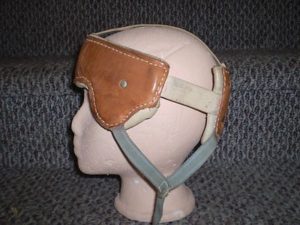
But I could play and I danced in the game of hockey, loving my precious ice-time. And I realize now just how basic water was to me, how taken for granted, how elemental in building my character and feeding my soul. I tumble home to water- and water-ice-memories from my youth, my beloved sprinklers, water pistols, and the crafts, rafts, lakes, rivers, dams, pools, rinks, and arenas of my existence.
